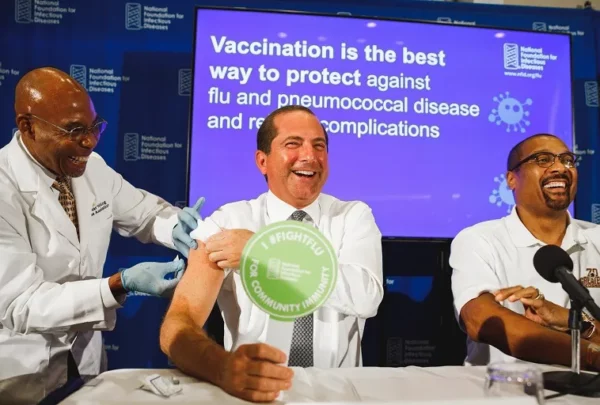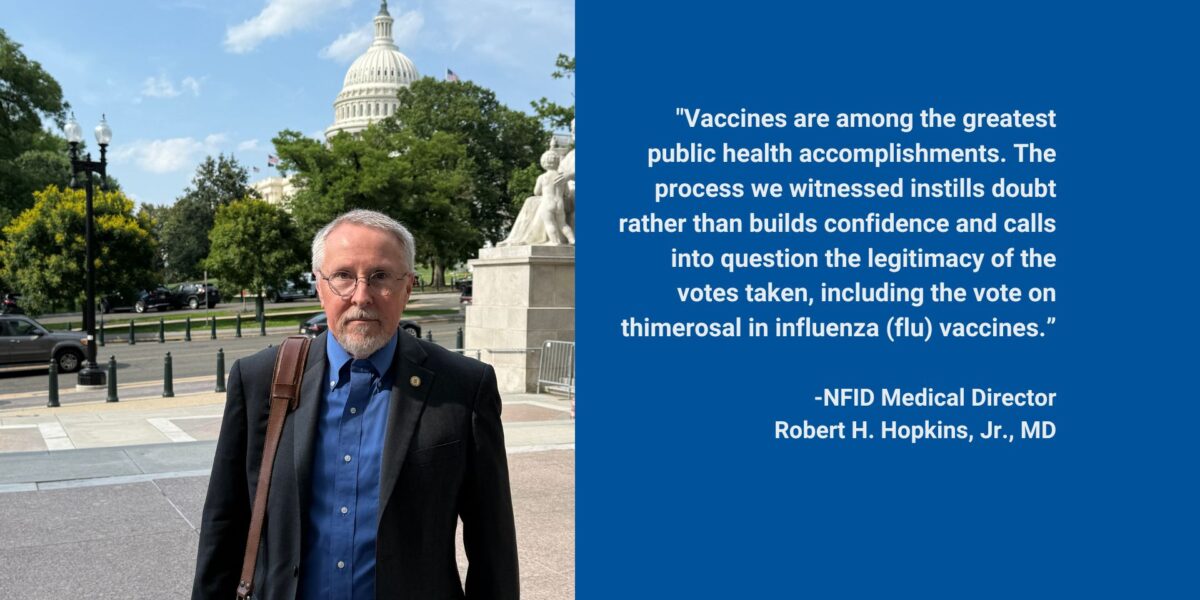
Fewer Than Half of US Adults Received an Influenza Vaccine Last Season; New Survey Shows Only 52 Percent Plan to Get Vaccinated This Season
Contact: Diana Olson at 301-656-0003 x140
Washington, DC (September 26, 2019) — New data released today by the National Foundation for Infectious Diseases (NFID) revealed that only 52 percent of US adults plan to get vaccinated against influenza (flu) this season. Representatives from NFID and other leading public health and medical organizations urged the public and healthcare professionals to follow the CDC recommendation for everyone age 6 months and older to get vaccinated against the flu annually.
 “Many people underestimate the severity of flu, yet we know flu causes hundreds of thousands of hospitalizations and tens of thousands of deaths each year in the United States,” said Secretary of Health and Human Services Alex M. Azar, II. “When it comes to protecting people from flu, our best preventive tool is an annual flu vaccine. It can safely prevent flu illnesses, hospitalizations, and deaths,” added Secretary Azar. In reviewing vaccine coverage estimates from the Centers for Disease Control and Prevention (CDC) for the 2018-2019 flu season, Secretary Azar noted, “we are making important gains in flu vaccination coverage in some groups of people, especially children, but in adults we see a disappointing plateau. We are under-utilizing this potentially life-saving resource.”
“Many people underestimate the severity of flu, yet we know flu causes hundreds of thousands of hospitalizations and tens of thousands of deaths each year in the United States,” said Secretary of Health and Human Services Alex M. Azar, II. “When it comes to protecting people from flu, our best preventive tool is an annual flu vaccine. It can safely prevent flu illnesses, hospitalizations, and deaths,” added Secretary Azar. In reviewing vaccine coverage estimates from the Centers for Disease Control and Prevention (CDC) for the 2018-2019 flu season, Secretary Azar noted, “we are making important gains in flu vaccination coverage in some groups of people, especially children, but in adults we see a disappointing plateau. We are under-utilizing this potentially life-saving resource.”
Overall, CDC estimates show that flu vaccination coverage has increased over the past decade. Flu vaccination coverage among children age 6 months to 17 years was 63 percent for the 2018-2019 flu season, after plateauing for several seasons. Overall, it is an increase from 51 percent in 2010-2011. The most noteworthy improvement since 2010-2011 has been in coverage among teens age 13 to 17 years, which increased by almost 20 percentage points to 52 percent last season, although this age group still has the lowest coverage among children. Vaccination coverage among adults has increased slightly over the past decade, but remains about 45 percent, which leaves more than half of US adults unprotected against flu each year.
Flu vaccination coverage varied significantly by state. During last flu season, vaccination coverage in adults ranged from 34 percent in Nevada to 56 percent in Rhode Island. Flu vaccination coverage in children ranged from 46 percent in Wyoming to 81 percent in Massachusetts. Non-Hispanic white adults had higher coverage rates than non-Hispanic black, Hispanic, Asian, and American Indian/Alaska Native adults and adults of other or multiple races. Among children, Asian children had higher coverage rates than children in all other racial/ethnic groups.
Amid national conversations on vaccine hesitancy and suboptimal flu vaccination rates in the US (despite the recommendation for everyone age 6 months and older to get vaccinated each year), NFID commissioned a survey to better understand beliefs about flu and pneumococcal disease, as well as attitudes and practices around adult vaccination.
“Our survey revealed that nearly a quarter of US adults at highest risk of flu-related complications—those who are 65 and older or who have an underlying condition like asthma, diabetes, and heart disease—do not plan to get vaccinated against flu this season. Nearly 60 percent of these individuals, who are also at increased risk for pneumococcal disease, report that they have never been advised to get vaccinated against pneumococcal disease,” said William Schaffner, MD, medical director of NFID. “We must continue to educate everyone, especially older adults (age 65 years and older) and those with chronic health conditions, about their risk for flu and pneumococcal disease. Pneumococcal vaccines can be given at the same time as a flu vaccine, so it’s a great time to speak with a healthcare professional about which vaccines are best for you.”
Secretary Azar and Dr. Schaffner were joined at today’s press conference by Patricia N. Whitley-Williams, MD, president-elect of NFID and professor at Rutgers Robert Wood Johnson Medical School, and William B. Borden, MD, associate professor of medicine and health policy at George Washington University, and chief quality and population health officer at GW Medical Faculty Associates. The panelists all led by example and got vaccinated against flu, along with Daniel B. Jernigan, MD, MPH, CDC Influenza Division director and Mark May, NFID flu ambassador and 1980 Outland Trophy winner.
“As a pediatrician specializing in infectious diseases, I have seen first-hand the devastating impact that flu and its complications can cause in children,” said Dr. Whitley-Williams. “During the 2018-2019 flu season, 135 flu-related pediatric deaths were reported to CDC. Unfortunately, we have heard about pediatric deaths even over the summer. The time is now to prioritize flu vaccination. It is so important that children get vaccinated before flu begins spreading in their communities.”
Vaccination rates among adults aged 18-49 years with at least one chronic health condition putting them at higher risk for flu-related complications was only 40 percent during the 2018-2019 flu season. “We need to do better,” said Dr. Borden, a preventive cardiology specialist. “Last flu season, approximately 93 percent of adults hospitalized for flu-related complications had at least one underlying medical condition, such as heart or lung disease. Vaccination against flu and pneumococcal disease must be part of disease management for people with chronic health conditions.”
Influenza Vaccine Supply and Options
For the 2019-2020 season, vaccine manufacturers have estimated that up to 169 million doses of influenza vaccine will be available in the US. The composition of the vaccines available this season has been updated to protect against the influenza viruses that research suggests will be most common during the 2019-2020 season.
For the 2019-2020 season, CDC recommends the use of any licensed, age-appropriate flu vaccine as soon as it is available in your community. Options include the following:
- Standard influenza vaccine, which includes four influenza viruses (quadrivalent—two influenza A and two influenza B), for children and adults age 6 months or older;
- Adjuvanted vaccine and high dose vaccine for adults age 65 years and older, both of which are designed to help initiate a more robust immune response;
- Flu vaccine grown in cell-culture (not eggs) for children age 4 years and older;
- Flu vaccine made using recombinant technology (another alternative to egg-based vaccine production) for adults age 18 years or older; and
- Live-attenuated influenza vaccine (LAIV) that is given via nasal spray for children and adults (who are not pregnant) age 2-49 years.
All vaccine options may not be available at all locations, so experts emphasized that people should not wait to get vaccinated if their first choice of vaccine is not available. To find locations where vaccines are available by zip code, visit https://vaccinefinder.org/.
Although not a substitute for getting an annual flu vaccine, health officials also stressed the importance of everyday preventive actions to decrease the spread of flu and the appropriate use of influenza antiviral drugs to treat influenza as part of the CDC “Take 3” approach to fight flu. Four licensed influenza antiviral drugs are recommended for use in the US this flu season: oseltamivir, zanamivir, peramivir, and baloxavir marboxil.
About the National Foundation for Infectious Diseases
Founded in 1973, the National Foundation for Infectious Diseases (NFID) is a non-profit 501(c)(3) organization dedicated to educating the public and healthcare professionals about the burden, causes, prevention, diagnosis, and treatment of infectious diseases across the lifespan. For additional information, visit www.nfid.org.
NFID supports the CDC ‘Take 3’ approach to flu prevention: 1. Get an annual flu vaccination (everyone age 6 months and older); 2. Take everyday preventive actions to stop the spread of germs; and 3. Take flu antiviral drugs if prescribed. Flu season is also a good time to make sure you are up to date on pneumococcal vaccines. #FightFlu #PreventPneumo
More information about influenza is available at www.nfid.org/flu and about pneumococcal disease at www.nfid.org/pneumococcal.
All vaccination coverage estimates from the 2018-2019 flu season were published online today and are available on the CDC FluVaxView website at www.cdc.gov/flu/fluvaxview/1819season.htm. The composition of 2019-2020 US flu vaccines is available at http://bit.ly/19-20flu-vaccines.
Attitudes about Flu and Pneumococcal Disease Prevention National Survey
This NFID-sponsored survey was conducted by NORC at the University of Chicago. Data were collected using the AmeriSpeak Omnibus®, a monthly multi-client survey using the NORC probability-based panel designed to be representative of the US household population. Interviews for this survey were conducted between August 15 and 18, 2019 with panel members randomly drawn from AmeriSpeak. Interviews were conducted in English. The final stage completion rate is 20.0 percent, the weighted household panel response rate is 30.3 percent, and the weighted household panel retention rate is 85.4 percent, for a cumulative response rate of 5.2 percent. The overall margin of sampling error is +/- 4.3 percentage points at the 95 percent confidence level, including the design effect. The margin of sampling error may be higher for subgroups.
Once the sample has been selected and fielded, and all the study data have been collected and made final, a poststratification process is used to adjust for any survey nonresponse as well as any noncoverage or under and oversampling resulting from the study specific sample design. Poststratification variables included age, gender, census division, race/ethnicity, and education. Weighting variables were obtained from the 2018 Current Population Survey. The weighted data reflect the US population of adults age 18 and over.
More information about the survey findings is available on the NFID website at www.nfid.org/national-poll-attitudes-about-flu-and-pneumococcal-disease-prevention/.
This news conference is sponsored by NFID in collaboration with and support from the Centers for Disease Control and Prevention, MedStar Visiting Nurse Association, professional societies and patient advocacy partners, and through unrestricted educational grants from AstraZeneca, Genentech, GSK, Merck & Co., Inc., and Seqirus. NFID also received funding and other support from Sanofi Pasteur. NFID policies prohibit funders from controlling program content.
###
Recent Press Releases

National Foundation for Infectious Diseases Announces 2025-2026 Board of Directors
NFID announces the appointment of an esteemed group of leaders serving as the 2025-2026 NFID Board of Directors

Statement on June 2025 Advisory Committee on Immunization Practices Meeting
NFID strongly supports the use of evidence-based guidance reviewed by qualified experts, within CDC and externally, to inform public health policy, and will work to protect the health of people across the US …

NFID Statement on the Importance of Federal Advisory Committees in Protecting Public Health
The National Foundation for Infectious Diseases (NFID) underscores the vital role that federal advisory committees play in informing public health decision-making and providing expert, evidence-based guidance on public health issues, including critical interventions to prevent infectious diseases
